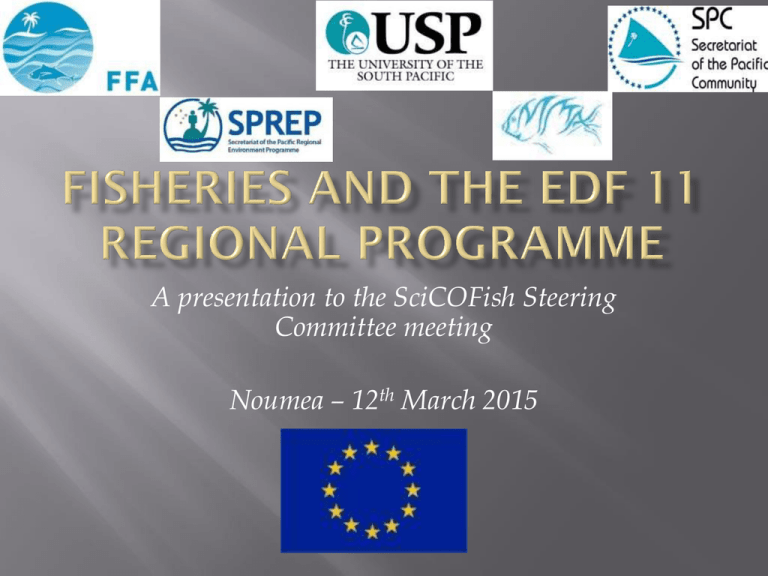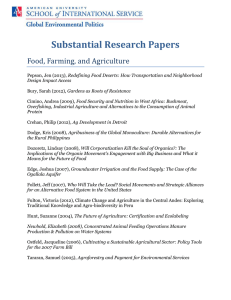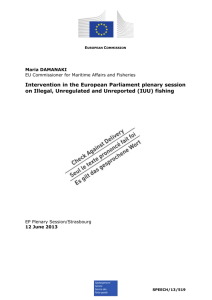A presentation to the SciCOFish Steering Committee meeting Noumea – 12 March 2015
advertisement

A presentation to the SciCOFish Steering Committee meeting Noumea – 12th March 2015 Draft Regional Indicative Programme has three sectors: Regional Economic Integration – aid for trade and private sector involvement - €78m; Sustainable management of natural resources (specifically oceanic and coastal) and waste €66m; Inclusive and accountable governance - €22m Note that values include €46 m ‘blending finance’ which will probably not be available for typical grant aid projects The preference is for a small number of relatively large programmes – 3-10 programmes; A fisheries programme is ‘a given’ from the perspective of the EU; Multi-agency programmes are preferred; Involvement of non- state actors (NGOs) is a plus; Cross-cutting programmes are also favoured and will be able to draw funds from more than one RIP sector; While building on past success, the EU, in particular, are looking for innovative initiatives and features (not ‘business as usual’); Support from national governments (steering committee) will be the main determinant of approval; Implementing agencies that have passed the 7-pillar assessment will be strongly preferred. Draft RIP submitted to Brussels Approval possible by March 2015 This will trigger invitation for proposals or expressions of interest Steering committee will review proposals and either approve, reject, or recommend merging with other projects Realistically, it is unlikely that any new projects will commence before early 2016 – and must be finished by 2023 Our proposal needs to be ready after discussion/endorsement at this meeting. SciCOFish €9 million SPC implements Project ends Mar. 2015 Focus on fisheries science for management tuna (2/3) coastal (1/3) DevFish 2 €8.2 million FFA lead agency Project end Feb. 2016 Tuna fishery development and combatting IUU Artisanal tuna fishing Also ACP Fish 2 (EDF9) – all ACP project with Pacific Hub – ended late 2013 Observer coverage Regional surveillance Market access Initial bio-economic assessments CC impacts on tuna Stronger industry associations New coastal management plans New resources and skills New requirements – IUU regulation New technology – e-reporting and e-monitoring; integrated information systems New approaches – regional ‘competent authority’ New partners – supporting NGOs in community based fisheries management New emphasis on capacity building and career development with USP New component to address ecosystem impacts with SPREP (biodiversity/iconic species) Overall Objective: Sustainable management and development of fisheries resources Project Purpose: Provide technical support and training to address constraints to improved management of fisheries and economic growth based on their sustainable exploitation. 7 Result areas. Tuna biology; Ecosystem analysis; Targetted small scale tagging; Bio-economic analysis; Analytical work on the purse-seine fishery and effort creep; Consultation with industry on bigeye bycatch. Funded under Aid for Trade focal sector Investment facilitation; Development policy support; Support to domestic industry; Regional ‘competent authority’ support unit; Assistance to comply with the EU IUU regulation and any new market requirements. Training in coastal resource assessment; Wide roll-out of community based management; Materials and training for community support workers; Support for coastal fisheries legal reforms. Implementation of national plans of action for IUU fishing; Sustainable observer training mechanisms; Roll-out of electronic reporting and electronic monitoring; Analysis of reporting and observer data; Training of coastal MCS officers; Maritime boundary delimitation and negotiations. Analysis of observer data for impact of fishing on marine megafauna; Identification of interaction hotspots; Targetted mitigation measures (e.g. circle hook exchange) and training in release techniques; Work with coastal communities on conservation initiatives. Development of accredited course at USP; Sustainable observer training; Young professional appointments/ secondments; Collaborative research projects (MSc, PhD) EU project management and reporting requirements met; Communication of project findings and results; Improved transparency in decision making; Visibility of EU assistance. JOBS EXPORTS 4,500 4,000 3,500 V m a i 3,000 l l u 2,500 l e i 2,000 o U n 1,500 S s $ 1,000 CATCH VALUE 500 2004 2005 2006 2007 2008 2009 2010 2011 2012 2013 OTHER INDICATORS MARKET ACCESS Number of countries and processing plants authorised to export to EU 12 10 10 8 7 PICs 6 4 4 2 3 Processing plants 2 1 0 2009/10 2010/11 2011/12 Increased financial returns (measured by value of harvest) Status of tuna species against regionallyagreed reference points Area under Locally Managed Marine Areas (LMMAs) Reduction in IUU in oceanic and coastal fishery operations Number of maritime boundary treaties signed Turtle populations assessed and impact of fisheries on them quantified and reduced Number of male and female students graduating from tertiary and technical/vocational courses Number and uptake of media releases casting the EU and project activities in a positive light. Very tentative budget at this stage – more detailed design required; At this stage no certainty of any funding; Indicative figure for the project is €40 million; Cost of each component €5-8 million; At this stage coastal component is the largest. and remember the best EDF regional projects all end in ……fish



